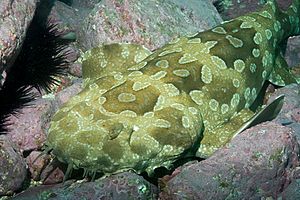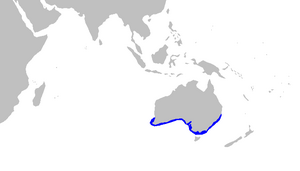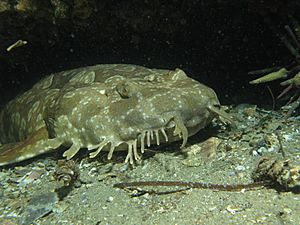Spotted wobbegong facts for kids
Quick facts for kids Spotted wobbegong |
|
|---|---|
 |
|
| Conservation status | |
| Scientific classification | |
| Genus: |
Orectolobus
|
| Species: |
maculatus
|
 |
|
| Range of spotted wobbegong (in blue) | |
| Synonyms | |
|
|
The spotted wobbegong (Orectolobus maculatus) is a type of carpet shark. It belongs to the family called Orectolobidae. This shark is found only in Australia. It is a large and strong shark, usually growing to be about 150 to 180 centimeters (about 5 to 6 feet) long.
Spotted wobbegongs can be green, yellow, or brown. They have special O-shaped spots all over their bodies. These sharks are active at night, which means they are nocturnal. During the day, they rest. At night, they hunt for fish and other small sea animals.
This shark gives birth to live young, which means it is ovoviviparous. The babies are born in the spring. During this time, male wobbegongs can act aggressively towards other males and even females. Spotted wobbegongs have been known to bite humans, sometimes without being provoked. These bites can cause serious wounds. People in Australia sometimes catch these sharks for food. However, the spotted wobbegong is not in serious danger. It is listed as a least-concern species on the IUCN Red List.
Contents
About the Spotted Wobbegong
Naming and Classification
The spotted wobbegong was first described by a scientist named Pierre Joseph Bonnaterre in 1778. He first put it in the group Squalus. Later, in 1788, he moved it to its current group, Orectolobus. So, its full scientific name today is Orectolobus maculatus.
The name Orectolobus comes from Greek words. It roughly means "stretched out lobe," which refers to parts of its body. The second part of its name, maculatus, is Latin for "spotted." This name perfectly describes the shark's spotted body pattern. People also call this shark by other names like carpet shark or tassel shark.
How It's Different from Other Wobbegongs
Sometimes, the spotted wobbegong has been confused with other similar sharks. For example, it was once thought to be the same as the dwarf spotted wobbegong (Orectolobus parvimaculatus). But the spotted wobbegong has smaller fins on its back. These fins also do not have the black marks that the dwarf spotted wobbegong has. This helps scientists tell them apart.
It has also been confused with the Gulf wobbegong (Orectolobus hatei) and the ornate wobbegong (Orectolobus ornatus). However, the spotted wobbegong has white marks and more skin flaps around its mouth. These features help scientists tell it apart from other wobbegong species.
The diagram below shows how the spotted wobbegong is related to some other wobbegong species:
| Genus Orectolobus |
|
||||||||||||||||||||||||||||||
Appearance
The spotted wobbegong has a large, strong body. It gets thinner past its pelvic fins. These sharks usually grow to be about 150 to 180 centimeters (5 to 6 feet) long. Some can even reach 320 centimeters (over 10 feet)!
Their bodies are green, yellow, or brown. They have a darker back and darker saddle-like markings. What makes them special are the O-shaped spots that cover their bodies. These spots help tell them apart from other sharks.
Around their eyes, they have six to ten small skin flaps. They also have a small bump above each eye. Their bodies are smooth and do not have ridges. Other features include skin flaps around their mouths, long whiskers (called barbels) near their nostrils, and large breathing holes (called spiracles).
Electroreceptors
Like other sharks, the spotted wobbegong has many tiny holes in its skin. These holes are called pores. They work as electroreceptors. These special sensors help the shark detect the electric fields that other animals create. This makes it easier for the wobbegong to find its prey, even in dark or murky water.
Scientists have studied these electroreceptors. They found that the spotted wobbegong has a very complex system for sensing electricity. This system is very important for how the shark finds its food.
Life and Habits
Habitat and Diet
The spotted wobbegong is a nocturnal shark. This means it rests during the day. It likes to hide in sandy areas, coral reefs, and coastal bays. Adult wobbegongs are often found on rocky reefs covered in algae or in areas with sea grass or sand. Younger wobbegongs usually live in estuaries, which are places where rivers meet the sea.
Because of its color and spots, the spotted wobbegong is very good at camouflaging itself on rocky seabeds. This helps it hide from both predators and prey. It eats a variety of animals, including fish like luderick, scorpionfishes, basses, and rays. It also eats invertebrates like crabs, lobsters, and octopuses. Like all wobbegongs, it has a short mouth and a wide throat. This allows it to suck up its prey easily. Sometimes, smaller animals even swim right up to the wobbegong, not realizing it's a predator!
Social Behavior
Spotted wobbegongs often gather in groups. Scientists used to think they grouped together randomly or just for food. However, a study from Macquarie University found something interesting. They discovered that spotted wobbegongs choose to hang out with certain other wobbegongs for "social" reasons. Some sharks even prefer to be alone.
The study watched 15 tagged sharks for 15 months. They found that most sharks (14 out of 15) spent time with more than one other shark. The size, gender, or how well they knew each other did not seem to affect which sharks grouped together. One researcher said that sharks interact in ways that are "much more complex than we predicted."
Reproduction and Life Cycle
Female spotted wobbegongs give birth in the spring. Their pregnancy lasts for almost a year. This species is ovoviviparous. This means the baby sharks develop inside the mother's body until they are ready to hatch. A mother wobbegong usually gives birth to 20 to 37 babies at a time.
During the breeding season, male wobbegongs in Sydney have been seen fighting with other males. Males have also been observed biting females during courtship. When they are first born, young wobbegongs are about 21 centimeters (8 inches) long. Male wobbegongs become ready to have babies when they reach about 60 centimeters (2 feet) in length.
Where They Live
The spotted wobbegong lives only in Australia. It usually lives in warm, tropical waters. They are found at depths of up to 218 meters (715 feet). Most sharks caught between 1882 and 1995 were found in waters between 20 and 176 meters (65 to 577 feet) deep.
They have been seen in Queensland, Victoria, South Australia, and Western Australia. This includes parts of the western Pacific Ocean and the eastern Indian Ocean. There are also some old reports of them in Tasmania and the Northern Territory, but these might not be correct. Sometimes, other fish species in Japan and the South China Sea have been wrongly identified as spotted wobbegongs.
Relationship with Humans
Shark Bites
Even though the spotted wobbegong is usually calm around people, it can sometimes be aggressive. Its main way to defend itself is to bite. These bites can cause serious wounds because the shark tends to hold on for a long time.
There are reports of wobbegongs biting people if they step on them or put a hand or foot near their mouth. Divers sometimes pull the shark's tail when it's resting during the day. This often makes the shark bite. The species can also attack if it's caught on a fishing line or in a net, or if it's speared. In one case, a spotted wobbegong bit off a fisherman's foot. They might also attack a person holding a fish that has been speared or hooked.
In 1789, Arthur Phillip, the first governor of New South Wales, wrote about a wobbegong he called "Watts's Shark." He said it fiercely attacked a dog:
... after having lain on the deck for two hours seemingly quiet, on Mr Watts's dog passing by, the shark sprang on it with all the ferocity imaginable, and seized it by the leg, nor could the dog have disengaged himself had not the people near at hand come to his assistance
There have been reports of attacks on humans that seemed to be unprovoked. This includes divers swimming above the seabed. However, it is often hard to know exactly which shark species was involved or what caused the incident. The International Shark Attack File lists 4 unprovoked attacks confirmed to be by the spotted wobbegong. None of these were deadly. The Australian Shark Attack File has recorded 51 unprovoked attacks by any wobbegong shark species between 1900 and 2009. None of these were fatal either.
Conservation Status
The spotted wobbegong is not considered severely threatened. It is listed as a species of least concern by the International Union for the Conservation of Nature (IUCN) as of 2015. Before that, it was listed as near threatened in 2003 and 2009.
However, fishing for commercial purposes is a main threat to this species in eastern Australia. Its meat is edible, so people catch it for food. In Queensland, it is sometimes caught by accident (as bycatch) but is not usually targeted. Historically, its skin was used for decoration, but it's not known if this still happens.
The table below shows some fishing rules for spotted wobbegongs in different parts of Australia:
| State | Number of sharks a person can catch or keep | Notes | References |
|---|---|---|---|
| New South Wales | 0 | Commercial fishers can catch up to 6 per day. They must be at least 130 cm long. | |
| Victoria | 1 | The limit is "one shark per person" of any species. No commercial fishing for wobbegongs happens here. | |
| South Australia | No limit | Listed as "in peril" by Conservation SA. | |
| Western Australia | 2 | The limit is "two sharks per person" of any combination of shark species. | |
| Queensland | 1 | The limit is "one shark per person" of any species, with a maximum length of 1.5 m. |
See also
 In Spanish: Tiburón alfombra manchado para niños
In Spanish: Tiburón alfombra manchado para niños



